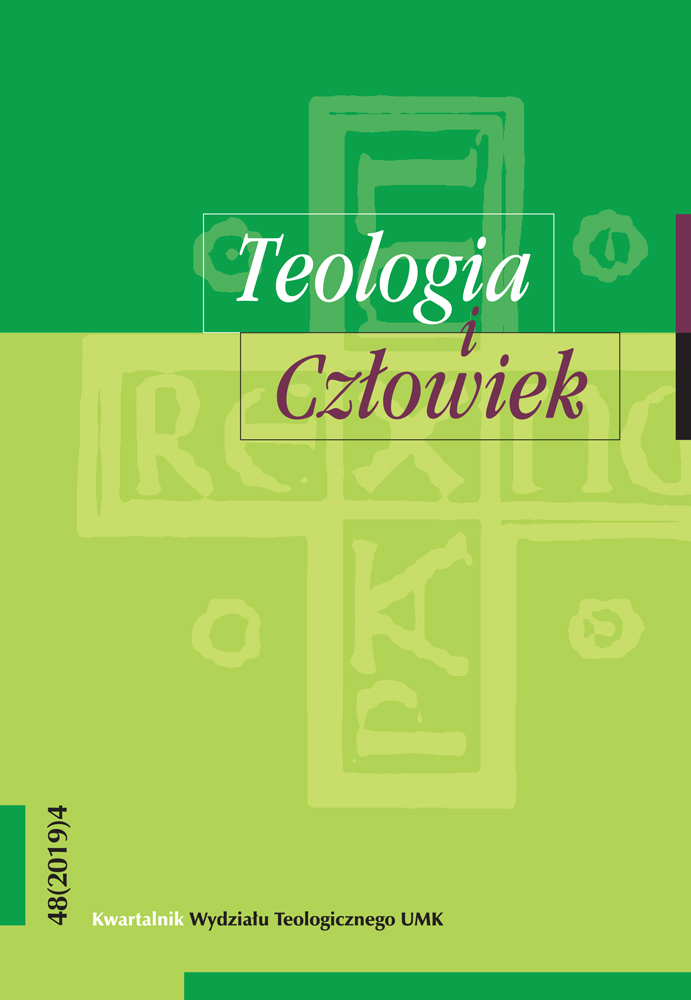The phenomenon of the conciliar reform of the rites of the consecration of virgins
DOI:
https://doi.org/10.12775/TiCz.2019.040Palabras clave
consecration, virginity, liturgy, reform, betrothal, marriage/nuptialsResumen
It is little known that there is a consecration of secular women in the Church, that is a special liturgical ceremony or rite, during which the woman promises that she will live in eternal purity for the Kingdom of God. The Church's intention is to make this ceremony primarily for women who are not associated in any institutions or communities, and who live individually and lead a secular lifestyle. The condition to admit the woman to this ceremony by the bishop is that the woman did not marry or not live in a state opposite to chastity. The whole novelty of current ceremonies is expressed in the admission to the consecration of secular virgins who remain in the secular world and carry out their professional and social work. Eight centuries after the dropping of the practice of the consecration of secular virgins, the Church, guided by the spirit of the times, returns to its old tradition and restores the rite of consecration to “their original owners”, that is secular women. Renewed ceremonies of consecration can be seen as a special expression of respect for a woman whose dignity is sometimes offended by a society dominated by myths of hedonism and consumption. The author deals with the diocesan identity and character of the class or status of virgins as being typical for this form of consecrated life. In addition, he raises issues related to the conditions of admitting the women to consecration, the theological assumptions of the rite and the form of its celebration.
Citas
Jan Paweł II, List apostolski Mulieris dignitatem, AAS (1988) 1653–1729.
Jan Paweł II, Posynodalna adhortacja papieska Vita consecrata, AAS (1996) 377–486.
Acta et documenta Concilio Oecumenico Vaticano II apparando. Series I (Antepraeparatoria) I–XVI, Series II (Praeparatoria) I–VII, Typis Polyglottis Vaticanis 1960–1962; 1964–1969.
Acta synodalia Sacrosancti Concilii Oecumenici Vaticani II, I–XXVII, Typis Polyglottis Vaticanis 1973–1969.
Synod Biskupów. IX Zgromadzenie Zwyczajne, Życie zakonne i jego posłannictwo w Kościele i świecie. Lineamenta, Watykan 1992.
Synod Biskupów. IX Zgromadzenie Zwyczajne, Życie zakonne i jego posłannictwo w Kościele i świecie. Instrumentum laboris, Watykan 1994.
Obrzędy konsekracji dziewic, Katowice 1999.
Albrecht B., Jungfrauenweihe für Frauen, die in der Welt leben, „Ordenkorespondenz“ 25 (1984) 298–305.
Augé M., La teologia della vita consacrata nei riti della consacrazione delle vergini e della professione religiosa, RPL 30 (1992) 3, 17–21.
Bolchi E.L., La consacrazione nell`Ordo virginum. Forma di vita e disciplina canonica, Roma 2002.
Bugnini A., L' “Ordo consecrationis virginum”, OsRom 7–8 Settembre 1970, 1–4.
Bugnini A., La riforma liturgica (1948–1975), Roma 1983, 762–765.
Calabuig I.M., Barbieri R., Struttura e fonti dell' “Ordo consecratio-nis virginum”, w: Liturgia opera divina e umana, Roma 1982, 479–530.
Calabuig I.M., Barbieri R., Consacrazione delle vergini, NDL 294–314.
Calabuig I.M., Barbieri R., Verginità consacrata nella Chiesa, NDL 1580–1599.
Calabuig I.M., La vergine consacrata vive e manifesta l'amore sponsale della Chiesa per Cristo, Roma 1995, msp (art. znajduje się w posiadaniu autora).
De Tryon-Montalembert R., Guerbert A., L'ordre des vierges, VC 3/4 (1983) 227–229.
De Tryon-Montalembert R., La vierge consacrée signe de l'amour de l'Église pour le Christ, VC 4 (1989) 226–238.
De Tryon-Montalembert R., Consécration des vierges et hiérarchie, VC 4 (1989) 239–242.
De Tryon-Montalembert R., Le renouveau conciliaire de la consécration des vierges, VC 6 (1981), 358.
Enrica R., Del Cinque S., La vita consacrata e l`Ordo virginum nell` insegnamento di Paoli VI, “Istituto Paolo VI”, notiziario n.67 (2014), ss. 69–85.
Kopeć J.J., Ruch liturgiczny, reforma i odnowa liturgiczna, RBL 4–5 (1985) 265–285.
Leclercq J., Vierge, virginité, DACL 15, 3094–3108.
Libera P., Duchowość dziewictwa konsekrowanego w świetle pism św. Ambrożego z Mediolanu, CT 64 (1994) 3, 87–99.
Nadolski B., Liturgika. Sakramenty, sakramentalia, błogosławieństwa, t. 3, Poznań 1992.
Nocent A., Il mistero di Cristo nella “Velatio sposae” e nalla “Velatio virginum”, RL 55 (1968) 3, 368–377.
Nocent A., La consacrazione delle vergini, w: I sacramentali e le benedizioni, t. 7, Genova 1989, 9–29.
Recchi S., L'ordine delle vergini, QDE 3 (1992) 141–150.
Recchi S., Valori qualificanti l'ordine delle vergini: oportunitŕ di un collegamento, w: Atti 4 e 5 Convegno dell' “Ordo Virginum”, San Bonifacio 1993, 17–32.
Righetti M., Manuale di storia liturgica, t. 4, Milano 1959.
Ruaro P., L'ordine delle vergini. I documenti, i riti, le norme, i principi spirituali e pastorali, Torino 1990.
Schlosser M., Alt – aber nicht veraltet. Die Jungfrauenweihe als Weg der Christusnachfolge, München 1992.
Stabińska J., Dziewictwo konsekrowane, Kraków 1990.
Szafraniec K., Konsekracja zakonna: sens i wartość, CT 54 (1984) 1, 37–44.
Tosetti G., Vergini consacrate nel mondo. Un ritorno alle origini, Bologna 1990.
Triacca A., Spirito Santo e liturgia. Linee metodologiche per un approfondimento, w: Miscellanea in onore di P. Cipriano Vagaggini, Roma 1980, 133–164.
Triacca A., Significato teologico-liturgico della “consacrazione cristiana” della verginità (Anámnesis – Epiclesis – Methexis), EL 96 (1982) 154–183.
Descargas
Publicado
Cómo citar
Número
Sección
Licencia
CC BY ND 4.0. Posiadaczem prawa autorskiego (Licencjodawcą) jest Autor, który na mocy umowy licencyjnej udziela nieodpłatnie prawa do eksploatacji dzieła na polach wskazanych w umowie.
- Licencjodawca udziela Licencjobiorcy licencji niewyłącznej na korzystanie z Utworu/przedmiotu prawa pokrewnego w następujących polach eksploatacji: a) utrwalanie Utworu/przedmiotu prawa pokrewnego; b) reprodukowanie (zwielokrotnienie) Utworu/przedmiotu prawa pokrewnego drukiem i techniką cyfrową (e-book, audiobook); c) wprowadzania do obrotu egzemplarzy zwielokrotnionego Utworu/przedmiotu prawa pokrewnego; d) wprowadzenie Utworu/przedmiotu prawa pokrewnego do pamięci komputera; e) rozpowszechnianie utworu w wersji elektronicznej w formule open access na licencji Creative Commons (CC BY-ND 3.0) poprzez platformę cyfrową Wydawnictwa Naukowego UMK oraz repozytorium UMK.
- Korzystanie przez Licencjobiorcę z utrwalonego Utworu ww. polach nie jest ograniczone czasowo ilościowo i terytorialnie.
- Licencjodawca udziela Licencjobiorcy licencji do Utworu/przedmiotu prawa pokrewnego nieodpłatnie na czas nieokreślony
PEŁEN TEKST UMOWY LICENCYJNEJ >>
Stats
Number of views and downloads: 522
Number of citations: 0



